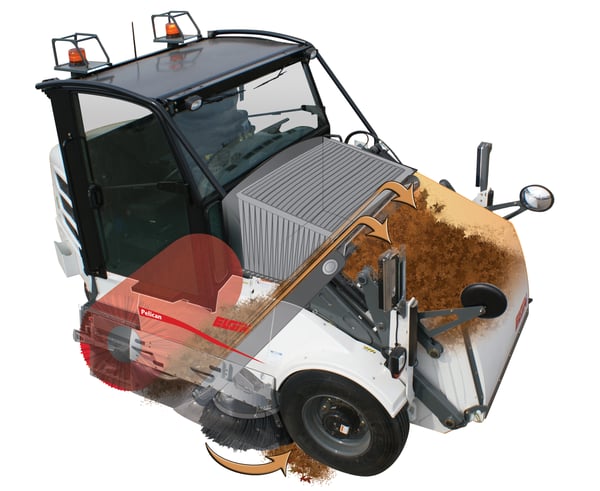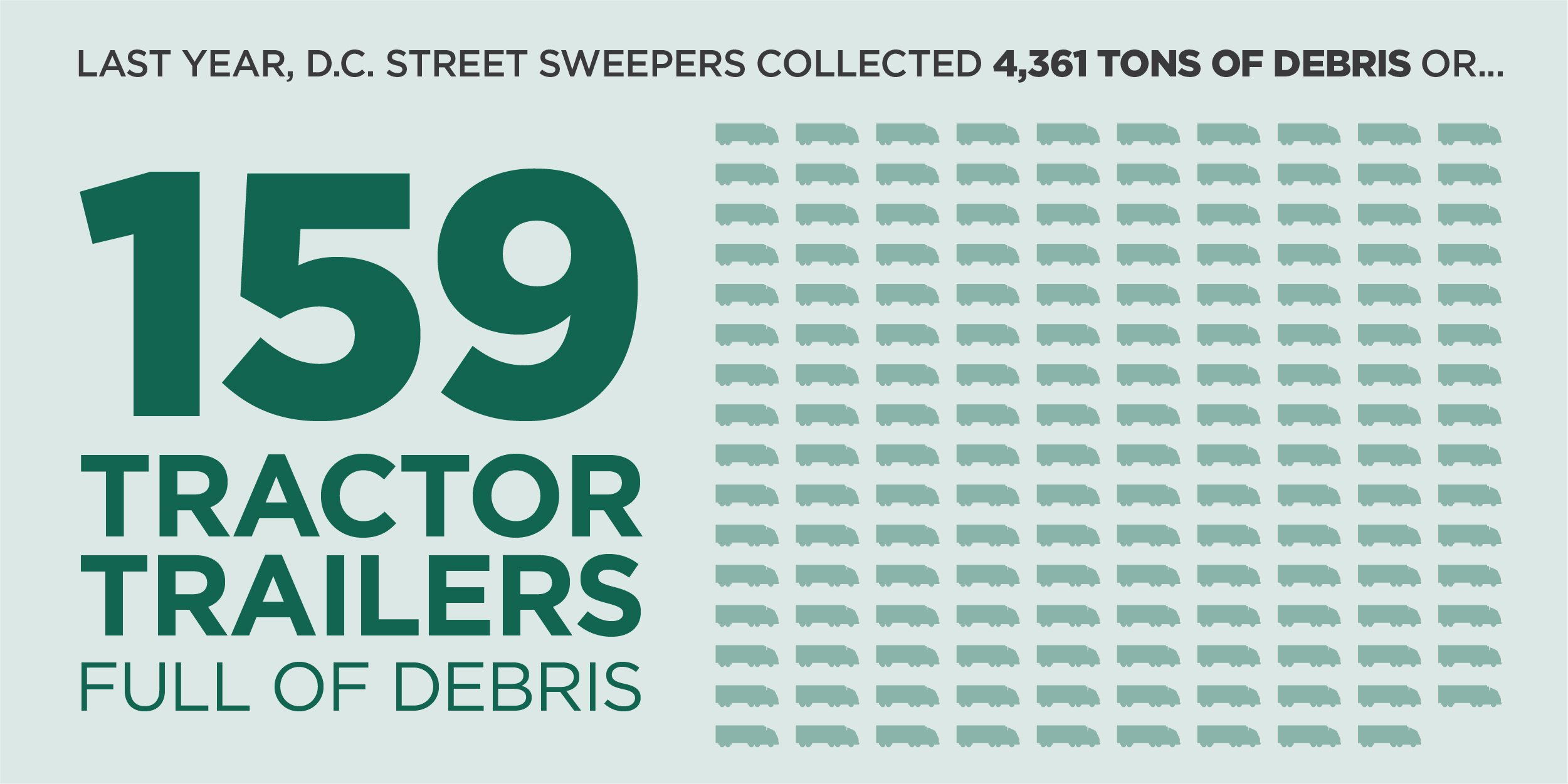Published on March, 26 2024
Have you ever wondered how street sweepers keep our roads clean and free from debris? Street Sweeping is over one hundred years old, and while the benefits and some of the basic mechanics have stayed the same, there have also been several innovations and changes – one machine may vary greatly from the next. The type of debris and surface of the street determine what kind of street sweeper is best for the job. In order to choose the right machine for the best possible outcome, you need to know how street sweepers work.
What Is a Street Sweeper?
A street sweeper is a specialized vehicle designed to clean and maintain the cleanliness of streets, roads, air, and stormwater. It plays a crucial role in maintaining the overall cleanliness and aesthetic appeal of urban areas. Street sweepers are equipped with various features and mechanisms that enable them to effectively remove debris, dust, leaves, and other waste from the surface of the road.
Types of Street Sweepers
There are different types of street sweepers available, each designed to suit specific cleaning requirements. Some of the common types include mechanical broom sweepers, regenerative air sweepers, vacuum sweepers, and waterless sweepers.
- Mechanical broom sweepers use rotating brushes to sweep and collect debris into a hopper or debris body.
- Regenerative air sweepers use a combination of suction and high-velocity air to pick up debris.
- Vacuum sweepers operate similarly but use a vacuum system to collect the debris.
- Waterless sweepers, on the other hand, use a combination of mechanical and vacuum systems to sweep and collect debris, and utilize shrouded brooms for dust control instead of water nozzles.
Regardless of the type, street sweepers share some common features. They usually have a wide sweeping path to cover a larger area in less time. Street sweepers are equipped with brushes or brooms that rotate at high speeds to dislodge debris from the surface. The collected debris is then transferred to a hopper or a collection bin for disposal. Many street sweepers also have a water system to dampen the surface and control dust while sweeping.
Mechanics of Street Sweepers
Street sweepers typically employ a combination of water, brooms, and vacuum systems to efficiently remove debris from the road surface. Let's take a closer look at each of these components and how they contribute to the sweeping process. The mechanism of street sweepers involves a series of steps that work together to achieve optimal cleaning results.
First, water is sprayed onto the road surface to help loosen dirt, dust, and other particles. This water serves as a lubricant, making it easier for the brooms and vacuum systems to capture the debris and to control dust.
Next, the brooms, usually made of strong polypropylene or steel bristles, rotate rapidly to brush the road surface and agitate the debris. As the side brooms sweep over the road, they dislodge the dirt and push it towards the center of the sweeper. Some side brooms extend beyond the width of the vehicle, allowing them to reach and clean the edges of the road.
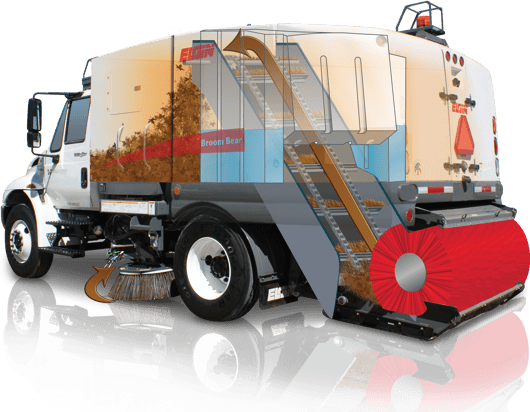
In mechanical sweepers, main brooms then sweep the debris onto a conveyor that deposits the debris into the hopper. The two conveyor systems are belts or squeegee elevators, and the best conveyor for the job depends on the collected debris. For larger debris, the belt is recommended, for smaller and lighter debris a squeegee elevator may be better. Mechanical sweepers are the most popular design, as well as least expensive. This makes sense given their versatility; they are put to work everywhere from urban and rural to industrial and construction environments.
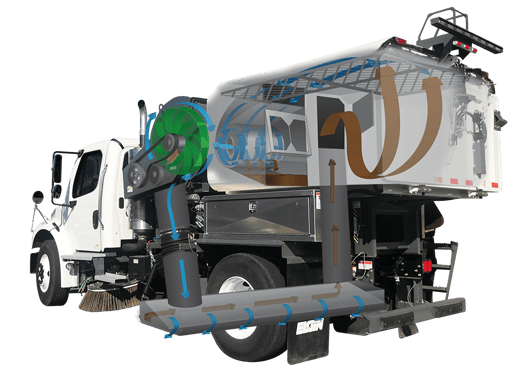
In regenerative air sweepers, the side brooms move debris from the curb line into the path of the sweeping head. The regenerative air system is a closed loop airflow system that forces high pressure air to the sweeping surface from one side of the sweeping head, dislodging fine particulate matter from the voids in the sweeping surface, and is then vacuumed into the hopper from the suction side of the sweeping head. As the debris ladened air enters the hopper, it is subjected to a complex path where the airstream is sped up and slowed down, allowing debris to fall into the hopper. Clean air then enters the fan housing, repeating the journey. Regenerative air sweepers are most effective on even surfaces and permeable pavement, and are the sweeper of choice for airports and racetracks.
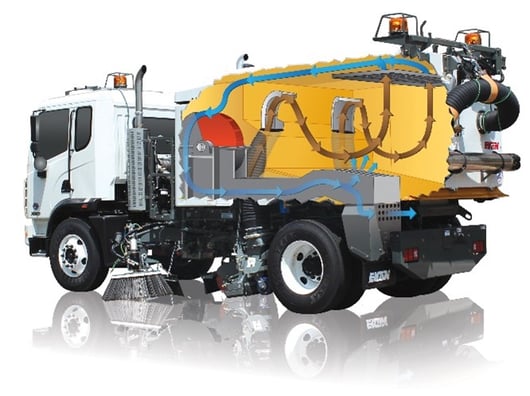
In vacuum sweepers, once the side brooms dislodge debris and move it to the center the vacuum moves it into the hopper. Like a shop vac for the road, this system creates a powerful suction force that pulls in the loosened debris, along with any dust or fine particles that might be present and deposits them in the hopper. Pure vacuum sweepers are ideally suited for uneven, patched roads and permeable pavement, as well as jobs involving dirt, sand, millings, and general applications.
In all types of sweeping the hopper can be emptied later at a designated disposal site. The sweeping process is designed to efficiently collect a wide range of debris, including leaves, litter, sand, and even larger items like broken glass or branches. By using a combination of water, brooms, and vacuum systems, street sweepers ensure that our roads remain clean, safe, and aesthetically pleasing.
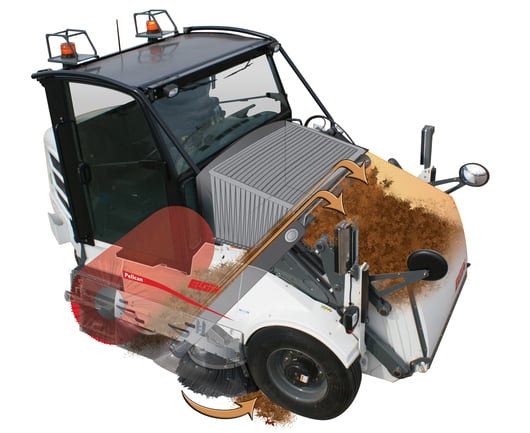
Waterless sweepers utilize the same mechanics as other sweepers, but have a skirt or cover to control dust and keep it within the sweepers path to be cleaned up and minimize kicking the dust up into the air. Waterless sweepers are often used when sweeping around elements that do not mix well with water, such as a cement plant, or in cold weather climates where there is a risk of the water freezing.
Knowing what result you are trying to achieve with street sweeping will help you know which type of sweeping system to employ.
Importance of Street Sweepers
Street sweepers play a vital role in maintaining clean and well-kept streets in our communities. They offer a range of benefits that contribute to a healthier environment, enhanced public safety, and improved aesthetics.
One of the primary benefits of clean streets is the reduction of pollution. Street sweepers effectively remove debris, trash, and pollutants from road surfaces, preventing them from entering storm drains and polluting our waterways. Mechanical sweepers are best for picking up large debris as they often have more space for debris to enter the hopper. By keeping streets clean, street sweepers help to improve water quality and protect aquatic life.
Illustration by Chris Tylec / WAMU
Benefits of Clean Streets
Additionally, street sweeping has a positive environmental impact. By removing leaves, grass clippings, and other organic materials, sweepers prevent them from decomposing and releasing harmful gases into the atmosphere. This helps to reduce greenhouse gas emissions and mitigate the effects of climate change.
While we can see the benefits of a street sweeper, even more important is the debris that we can’t see. Street sweepers pick up particulate matter that can also get into our water systems, and our air. When street sweepers clean up particulate matter it prevents the microscopic pollution from being kicked up into the air by cars on the road. Particulate matter is small enough to be inhaled, which makes cleaning up this pollution important for air quality. Without street sweeping the particulate matter will likely end up washed into storm drains when it rains, which makes street sweeping a helpful measure in preventing water pollution. Regenerative air and vacuum sweepers are particularly good at picking up the lighter and finer particulate matter.
Street sweepers also play a crucial role in enhancing public safety. They remove hazardous materials such as broken glass, nails, and other sharp objects that can pose a threat to pedestrians, cyclists, and motorists. By keeping streets clean and free from debris, sweepers can help to prevent accidents and injuries.
Furthermore, street sweepers contribute to the overall aesthetics of our neighborhoods. Clean streets create a positive first impression and make our communities more inviting. Well-maintained streets can boost property values and attract businesses, residents, and tourists.
When it comes to street sweeping, Elgin Sweeper is a leading provider of innovative and efficient sweepers. Their state-of-the-art technology ensures thorough and effective cleaning while minimizing environmental impact. With a range of sweepers designed for different applications, Elgin Sweeper offers reliable solutions to keep our streets clean and safe.

